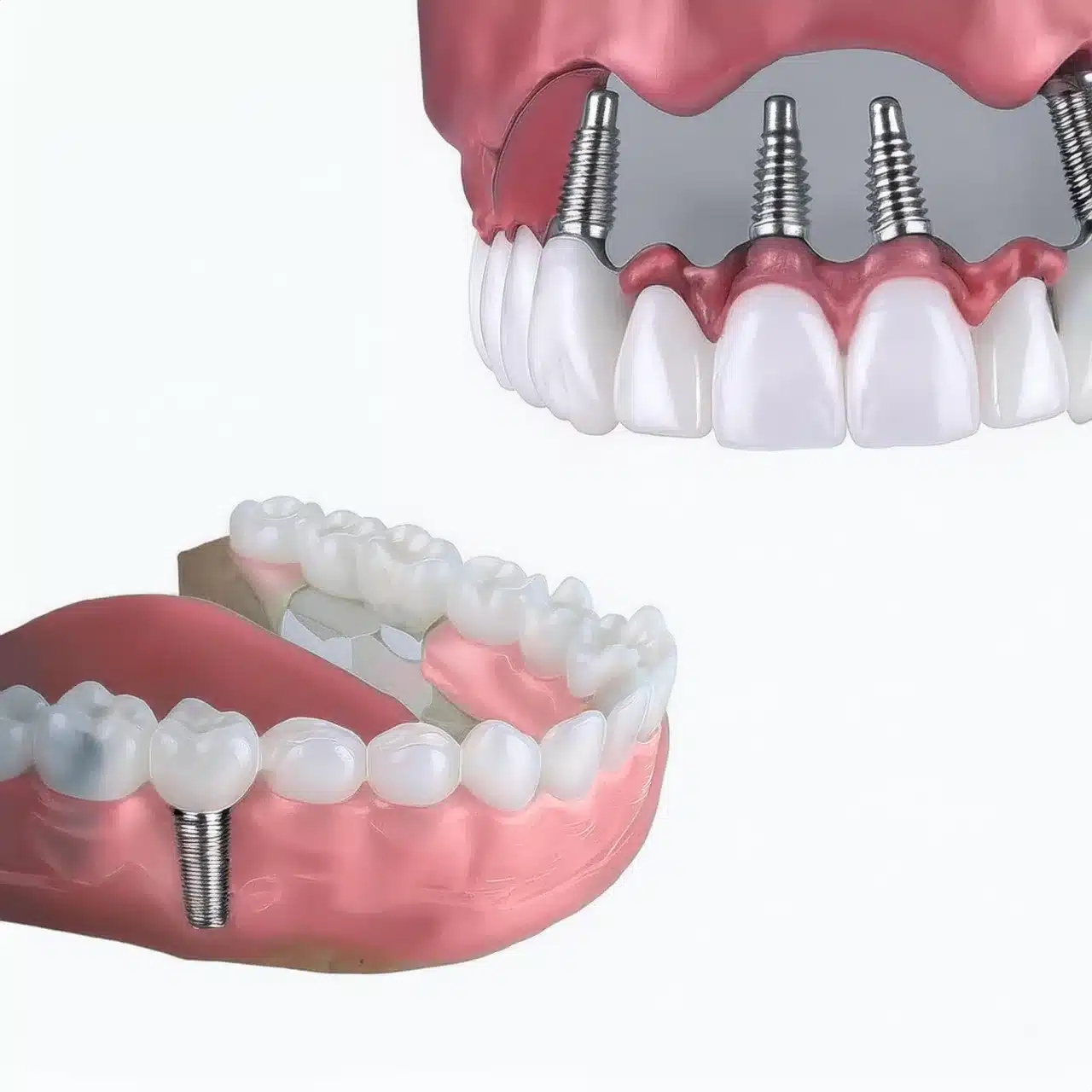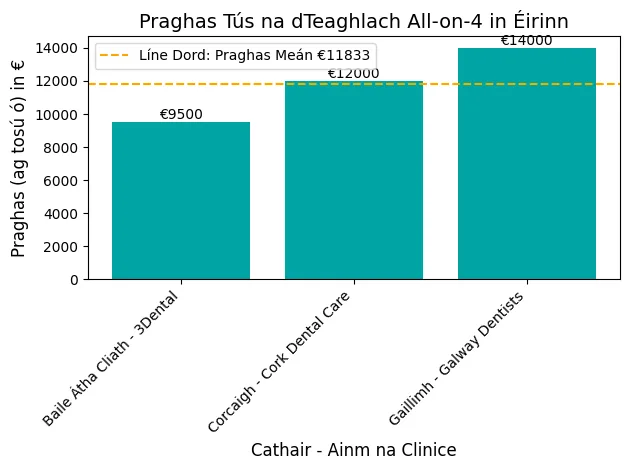All-on-4 vs. traditionell Zahnimplantate - Welches ist das Beste für Ihr Lächeln und Ihre Mundgesundheit?
Wenn Sie Folgendes in Betracht ziehen Zahnimplantat-Alternativen, Sie fragen sich wahrscheinlich, worin die Unterschiede zwischen den beiden bestehen und welche Lösung für Sie am effektivsten und dauerhaftesten ist.
Was ist der Unterschied zwischen All-on-4 und herkömmlichen Zahnimplantaten?
All-on-4-Implantate bieten eine schnellere, weniger invasive Option mit einer Erfolgsrate von 98% und einer Erholungszeit von 1-3 Tagen. Herkömmliche Implantate können bei mehreren Operationen bis zu 12 Monate dauern. Wichtige Punkte: All-on-4 erfordert nur 4 Implantate und erfordert nur selten eine Knochentransplantation, was es kosteneffektiv macht, während herkömmliche Implantate 6-8 Implantate erfordern und oft teurer sind.
| Aspekt | All-on-4 | Traditionell |
|---|---|---|
| Verfahren Zeit | 1-3 Tage | bis zu 12 Monate |
| Anzahl der Implantate | 4 Implantate | 6-8 Implantate |
| Knochentransplantation | Selten erforderlich | Oft notwendig |
| Kosten | Kosteneffizienter für den vollständigen Ersatz von Bögen | Teurer bei Mehrfachimplantaten |
All-on-4 Vorteile
Schnelleres Verfahren und kürzere Erholungszeit
All-on-4-Zahnimplantate sind auf Schnelligkeit ausgelegt.
Im Gegensatz zu herkömmlichen Implantaten, die mit mehreren Operationen und Heilungszeiten bis zu 12 Monate in Anspruch nehmen können, kann All-on-4 an einem Tag mit einer Erholungszeit von 1-3 Tagen durchgeführt werden.
Bei der Betrachtung Zahnimplantate vs. Zahnersatz, Implantate bieten eine dauerhafte, festsitzende Lösung, die die Unannehmlichkeiten einer herausnehmbaren Zahnspange überflüssig macht.
Der Grund dafür ist, dass bei All-on-4 nur 4 Implantate benötigt werden, um einen kompletten Zahnbogen zu stützen, ohne Knochentransplantation und ohne zusätzliche Operationen (1).
Kostenvergleich mit herkömmlichen Implantaten
All-on-4 ist nicht nur schneller, sondern auch kostengünstiger.
Bei herkömmlichen Implantaten sind mehrere Implantate und Verfahren erforderlich, was die Gesamtkosten in die Höhe treiben kann.
Bei All-on-4 werden weniger Implantate verwendet, so dass weniger chirurgische Kosten anfallen und eine erschwinglichere Lösung für den Ersatz des gesamten Zahnbogens geboten wird.
Im Vergleich zu herkömmlichen Implantaten können die Patienten bis zu 30% einsparen (2).

Mundgesundheit und Funktionsfähigkeit
All-on-4-Implantate bieten eine hervorragende Stabilität und Funktionalität, so dass die Patienten einen natürlichen Biss und eine verbesserte Mundgesundheit haben.
Die 4 Implantate sind strategisch so platziert, dass sie maximalen Halt bieten und den Druck auf den Kieferknochen verringern, so dass der Knochenverlust im Laufe der Zeit minimal ist.
Dies verbessert nicht nur die Mundgesundheit, sondern auch die Lebensqualität der Patienten, da sie mit Selbstvertrauen essen, sprechen und lächeln können (3).

Wann man sich für traditionelle Zahnimplantate entscheidet
Ersatz eines einzelnen Zahns
Traditionelle Zahnimplantate sind oft die beste Option für den Ersatz einzelner Zähne.
All-on-4 wurde für den Ersatz des gesamten Zahnbogens entwickelt. Herkömmliche Implantate können so zugeschnitten werden, dass sie einzelne Zähne ersetzen und so eine präzisere und natürlichere Lösung bieten.
In einer Studie wurde festgestellt, dass herkömmliche Implantate eine Erfolgsquote von 95% für den Ersatz eines einzelnen Zahns haben, so dass sie eine zuverlässige Option für Patienten sind, die einen oder mehrere Zähne ersetzen müssen (4).

Fälle, die eine Knochentransplantation erfordern
Herkömmliche Zahnimplantate werden auch in Fällen empfohlen, in denen eine Knochentransplantation erforderlich ist.
All-on-4-Implantate erfordern aufgrund ihrer strategischen Platzierung nur selten eine Knochentransplantation, während herkömmliche Implantate oft zusätzliche Knochenunterstützung benötigen, um Stabilität und Langlebigkeit zu gewährleisten.
Ein Fallbericht hat gezeigt, wie wichtig die Knochentransplantation bei herkömmlichen Implantatverfahren ist und wie sie die Erfolgsrate des Implantats erhöhen kann (2).
Alternativen zu Zahnimplantaten
Zahnimplantate sind eine beliebte Lösung bei Zahnverlust, da sie langlebig sind und natürlich aussehen.
Sie werden chirurgisch in den Kieferknochen eingesetzt, um eine stabile Grundlage für künstliche Zähne zu schaffen.
Das Verfahren besteht aus mehreren Schritten: Einsetzen des Implantats, Einheilung und Befestigung der Krone.
Zahnimplantate haben hohe Erfolgsquoten und langfristige Vorteile, weshalb sie für viele Patienten, die eine dauerhafte Zahnersatzlösung suchen, eine bevorzugte Wahl sind.
Der Prozess kann jedoch langwierig sein und erfordert möglicherweise eine Knochentransplantation, wenn der Kieferknochen nicht dicht genug ist (1).

Schlussfolgerung & Key-Takeaways
Wichtigste Erkenntnisse
Erfolgsquote: All-on-4 98%, traditionelle Implantate 95% für Einzelzahnersatz (1).
Erholungszeit: All-on-4 1-3 Tage, traditionelle Implantate 12 Monate (2).
Kostengünstig: All-on-4 für den gesamten Zahnbogen, traditionelle Implantate teurer wegen mehrerer Implantate und Verfahren (3).
Schlussfolgerung
Zusammenfassend lässt sich sagen, dass sowohl All-on-4 als auch herkömmliche Zahnimplantate eine Lösung für den Zahnverlust darstellen, die jeweils ihre eigenen Vor- und Nachteile haben.
Wenn Patienten die Unterschiede und Vorteile der einzelnen Implantattypen kennen, können sie eine fundierte Entscheidung treffen, die für sie richtig ist.

FAQ
Referenzen
(1) Jung Min Cho et al. Long-term steroid therapy and Denosumab treatment leading to peri-implant medication-related osteonecrosis of the jaw: a case report. J Dent Implant Res. 2024;43(3):27-32.
(2) Hae-Seok Lee et al. A retrospective study on the factors associated with marginal bone loss of short implants placed in posterior regions. J Dent Implant Res. 2023;42(3):46-52.
(3) Tae-Gyu Kang et al. Sofortige Implantation mit Enukleation der Zyste des Ductus nasopalatinae: Ein Fallbericht. J Dent Implant Res. 2023;42(4):53-59.
Artikel: Sofortige Implantation mit Enukleation der Zyste des Ductus nasopalatinae: Ein Fallbericht
(4) Hoi-Bin Jeong et al. Postoperative Herausforderungen bei gestielten bukkalen Fettpolstertransplantaten: MRT-Bewertung und die Rolle der Knochentransplantation für die Regeneration der Oberkieferwand. J Dent Implant Res. 2023;42(4):67-71.




